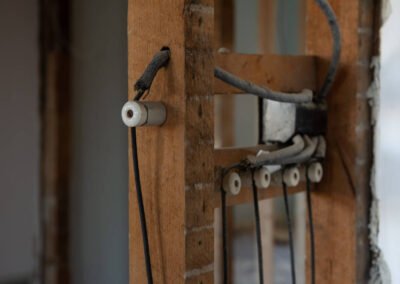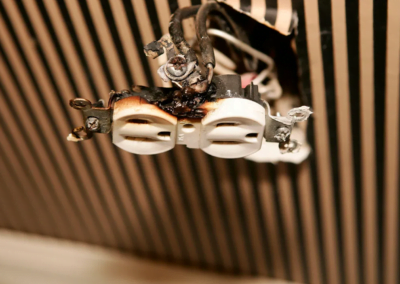Replace Old, Unsafe Wiring, Mississauga
Older homes typically use the “knob and tube” wiring method or aluminum wiring, which are outdated and can be unsafe. We can assess your home for safety and replace old wiring with safer systems.
Request InformationSchedule Service
Replace Old, Unsafe Wiring, Mississauga
Since wiring is hidden behind the walls, it’s often forgotten about and thought of as a benign issue. However, the longer a home has gone without renovations, the more likely it is to have outdated wiring. This can not only begin causing problems around the home, but can compound in damage and end up being incredibly dangerous in the long-run. To ensure the short-term and long-term healthy functioning of your home, replace your old, unsafe wiring.
One of the top causes of residential structural loss is caused by electrical distribution equipment. Hundreds of residential fires per year are sparked by faulty wiring or issues with electrical outlets, pointing to their prevalence and how often these problems are overlooked. This also illustrates how much homes are in dire need of upgrades. Preventing the worst from happening means assessing the current state of your wiring and acting accordingly.
The earliest type of wiring still present in older homes today is knob and tube wiring. Houses with a foundation built from the 1900s to as late as the 1970s utilized knob and tube wiring, which over time was realized to be a safety hazard. This kind of wiring is usually found in basements or attics, with the distinct appearance of tubes connected by porcelain white knobs suspended in the air. It’s not uncommon, however, for knob and tube wiring to have been hidden behind walls by previous homeowners. This ‘spider webbing’ can be dangerous as well, and in these cases, the only way to identify it is by having an electrician send a tiny camera inside the walls to have a look around.
Not only can older wiring be unsafe, but a house that does not adhere to modern safety regulations is likely to have insurance issues. Most insurance companies or mortgage lenders assessing homes with outdated wiring are likely to determine that it’s too much of a risk, preventing your home from being insured. Securing financing to buy a home and obtaining a mortgage for a house with outdated wiring (especially knob and tube wiring) can be nearly impossible until electrical upgrades have taken place.
Contact MADE ELECTRIC for more information on replacing old, unsafe wiring! We operate within the GTA to assess the safety of your home and ensure that it’s operating with the safest possible wiring system.
Frequently Asked Questions (FAQs)
Why is outdated wiring dangerous?
Outdated wiring can be dangerous for many reasons, but the main reason to upgrade your wiring is due to quickly advancing technology. The demand for electricity has increased significantly over the years, causing heavier electrical loads on average as stronger electrical devices and appliances pull more. With how quickly technology changes these days, older wiring systems have become obsolete and incompatible. Placing strain on older wiring systems is a fire hazard, so it’s much safer to have it upgraded as soon as possible.
The older a wiring system is, the more likely it has compounded damage and worn down, especially without regular inspection and maintenance. Systems like knob and tube wiring, too, tend not to have an electrical ground, which is required now for safety.
What is another form of wiring considered to be outdated?
Other than knob and tube wiring, aluminum wiring was used in homes back when copper prices were still too expensive to be considered for regular use en masse. From the 1960s to 1970s, aluminum wiring became popular for its affordability and cost effectiveness, as well as its malleability. However, since aluminum is so soft, wiring can fray or become loose over time and must be inspected and maintained every 3-5 years. Upgrading to copper wiring today is a safer alternative.
What can faulty wiring consist of?
Faulty wiring includes improper connections. This can include work done by unlicensed individuals. Since wiring is often thought of as a simple and accessible system, homeowners can believe that it’s better to alter wiring on their own. However, this can end up greatly compromising safety as improper connections and splices can occur.
Renovations or changes to the home can also be a contributing factor, including adding insulation to wall cavities. If you still have knob and tube wiring, doing this or simply covering them up can lead to your wiring overheating, which is incredibly dangerous. Faulty wiring should be corrected as soon as possible.




